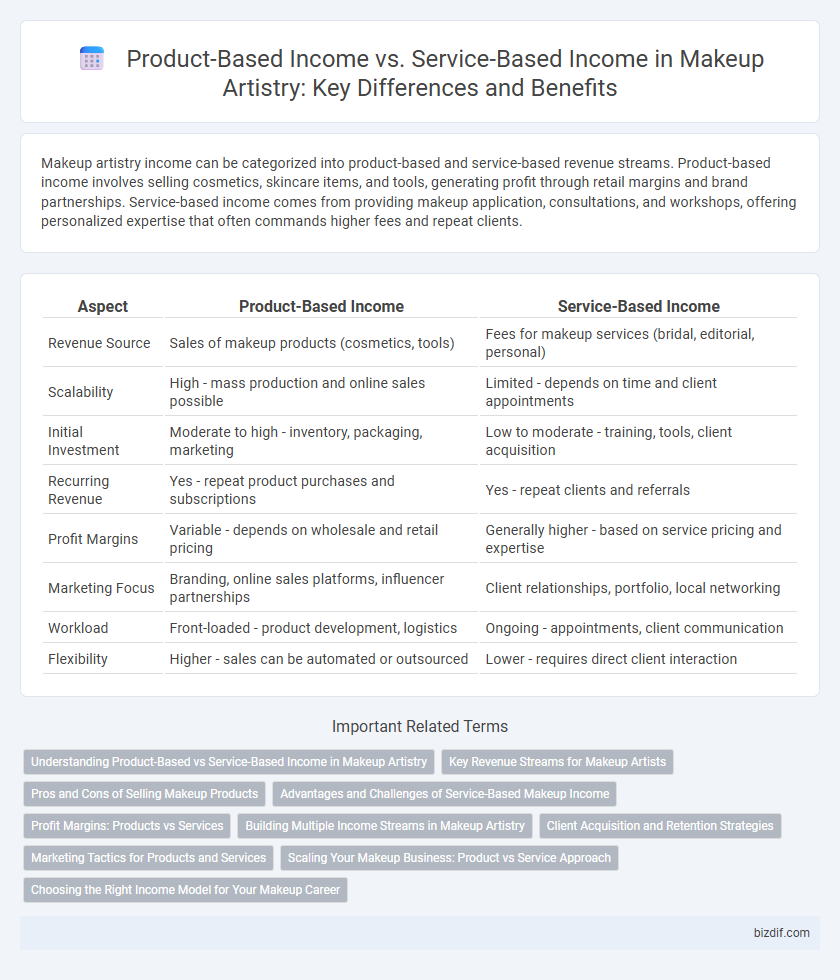Makeup artistry income can be categorized into product-based and service-based revenue streams. Product-based income involves selling cosmetics, skincare items, and tools, generating profit through retail margins and brand partnerships. Service-based income comes from providing makeup application, consultations, and workshops, offering personalized expertise that often commands higher fees and repeat clients.
Table of Comparison
| Aspect | Product-Based Income | Service-Based Income |
|---|---|---|
| Revenue Source | Sales of makeup products (cosmetics, tools) | Fees for makeup services (bridal, editorial, personal) |
| Scalability | High - mass production and online sales possible | Limited - depends on time and client appointments |
| Initial Investment | Moderate to high - inventory, packaging, marketing | Low to moderate - training, tools, client acquisition |
| Recurring Revenue | Yes - repeat product purchases and subscriptions | Yes - repeat clients and referrals |
| Profit Margins | Variable - depends on wholesale and retail pricing | Generally higher - based on service pricing and expertise |
| Marketing Focus | Branding, online sales platforms, influencer partnerships | Client relationships, portfolio, local networking |
| Workload | Front-loaded - product development, logistics | Ongoing - appointments, client communication |
| Flexibility | Higher - sales can be automated or outsourced | Lower - requires direct client interaction |
Understanding Product-Based vs Service-Based Income in Makeup Artistry
Product-based income in makeup artistry stems from selling cosmetics, tools, and branded accessories directly to clients or through retail channels, providing a scalable revenue stream with potentially higher profit margins. Service-based income arises from performing makeup applications, consultations, and tutorials, relying heavily on the artist's skill, reputation, and client retention for consistent earnings. Balancing both income types allows makeup artists to diversify revenue, mitigate risks, and build a sustainable business model tailored to varying market demands.
Key Revenue Streams for Makeup Artists
Makeup artists generate significant revenue through product-based income by selling cosmetics, skincare items, and exclusive beauty tools, capitalizing on brand partnerships and product endorsements. Service-based income remains a primary revenue stream, including bridal makeup, editorial shoots, special events, and personalized beauty consultations, which offer high-profit margins and repeat client potential. Diversifying between high-quality product sales and premium makeup services maximizes earnings and creates a sustainable financial model for professional makeup artists.
Pros and Cons of Selling Makeup Products
Selling makeup products generates scalable income by reaching a broader audience beyond local clients, offering potential for passive revenue through online sales. However, inventory management, supplier reliability, and initial investment costs present significant challenges that can impact profitability. Unlike service-based income, product sales require marketing efforts to build brand loyalty and handle customer support, which may demand substantial time and resources.
Advantages and Challenges of Service-Based Makeup Income
Service-based makeup income offers personalized client experiences, fostering strong relationships and repeat business that enhance long-term earnings. It enables artists to showcase their skills directly, leading to higher client satisfaction and premium pricing opportunities. Challenges include inconsistent appointment scheduling and dependence on client flow, which can create fluctuations in monthly revenue.
Profit Margins: Products vs Services
Product-based income in makeup artistry often yields higher profit margins due to bulk purchasing discounts and brand markups, allowing artists to capitalize on resale opportunities with minimal additional labor. Service-based income typically involves lower margins since it requires direct time investment per client, with costs including supplies, studio space, and skill-hour rates limiting profitability. Balancing product sales with high-value services maximizes overall profit margins by diversifying income streams and leveraging both fixed and variable costs efficiently.
Building Multiple Income Streams in Makeup Artistry
Makeup artists can enhance financial stability by balancing product-based income, such as selling cosmetics and tools, with service-based income from client appointments and special events. Diversifying revenue streams through online tutorials, brand collaborations, and retail partnerships creates multiple income avenues. Leveraging both product sales and personalized services maximizes earnings and fosters business growth in the competitive makeup artistry industry.
Client Acquisition and Retention Strategies
Product-based income in makeup artistry relies heavily on effective client acquisition through targeted social media campaigns and influencer collaborations to boost sales of cosmetics and tools. Service-based income depends on retention strategies such as personalized consultations, loyalty programs, and exceptional client experiences that encourage repeat bookings for makeup applications and lessons. Combining both approaches with tailored marketing ensures a balanced revenue stream and sustained business growth.
Marketing Tactics for Products and Services
Maximizing product-based income in makeup artistry requires targeted marketing strategies such as influencer partnerships, social media advertising, and limited-time promotions to drive sales and brand loyalty. Service-based income benefits from personalized marketing efforts including client testimonials, loyalty programs, and showcasing before-and-after transformations to highlight expertise and build trust. Employing data analytics to monitor customer preferences enhances both product and service campaigns, ensuring tailored marketing that boosts revenue streams effectively.
Scaling Your Makeup Business: Product vs Service Approach
Scaling your makeup business involves balancing product-based income, such as selling cosmetics and beauty tools, with service-based income from makeup application and personalized consultations. Product sales offer passive revenue opportunities and brand expansion through online platforms, while services deliver higher profit margins and client loyalty through customized experiences. Prioritizing a hybrid model leverages diversified income streams, enhancing financial stability and long-term growth in the competitive beauty industry.
Choosing the Right Income Model for Your Makeup Career
Makeup artists must evaluate product-based income from selling cosmetics versus service-based income from client appointments to maximize earnings and career growth. Product sales generate passive income but require inventory management and marketing, while services offer immediate cash flow and personalized client interactions that build reputation. Prioritizing a balanced mix aligned with individual skills and market demand ensures sustainable success in the competitive makeup industry.
Product-based income vs Service-based income Infographic

 bizdif.com
bizdif.com